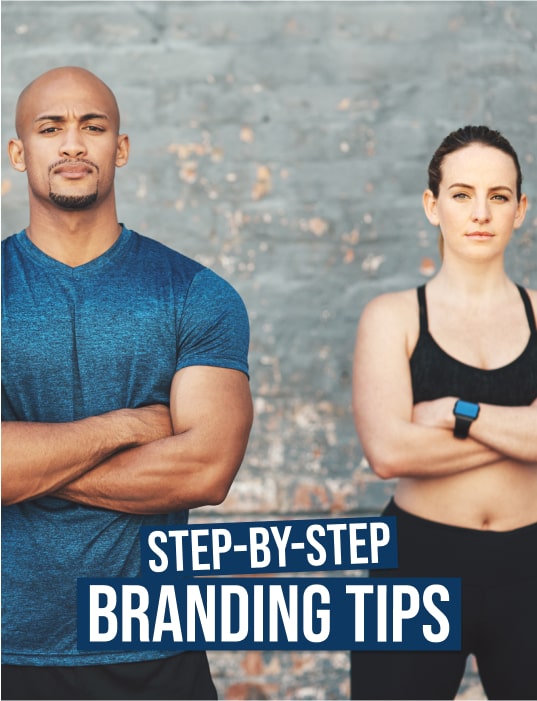Are You Earning Up to Your Potential?
Most personal trainers are undervaluing their time and skills. Our Personal trainer Revenue Calculator helps you find out what you should be making, and how to get there.
No guesswork. Just real numbers.
.jpg)
If you're in the fitness industry, you already know how competitive it can be. With so many personal trainers, online coaches, and fitness professionals vying for attention, building a fitness brand that truly stands out is no small feat. But here’s the good news: it’s entirely possible. By following a step-by-step approach and focusing on authenticity, creativity, and strategy, you can build a unique fitness coaching brand that attracts clients and achieves long-term success.
In this article, we’ll walk you through a detailed plan for creating a strong brand identity for your fitness business. Whether you run a personal training business, an online personal training business, or a hybrid coaching model, these branding tips for personal trainers will help you stand out in a crowded market.
{{instagram-username-form="/blog-instagram-username-components"}}
Step 1: Define Your Brand Identity
Before you can start attracting new clients, you need a clear and compelling brand identity. Ask yourself: What does my brand truly represent? And who exactly am I trying to help on their fitness journey? Your brand identity should reflect your core values, your personality as a coach, and the unique selling proposition that sets you apart from other personal trainers in the fitness industry.
Key elements to define include:
- Business name: Choose something memorable, meaningful, and fully aligned with your fitness services and brand vision.
- Brand personality: Are you energetic and high-energy, tough-love and disciplined, supportive and nurturing, or holistic and wellness-driven? Your tone and approach matter more than you think.
- Visual branding: Your logo, color palette, and overall design style should resonate with your target audience and make your brand instantly recognizable.
- Unique selling proposition: Clearly define why potential clients should choose you over other personal trainers or fitness professionals.
A strong and consistent brand identity helps build recognition, trust, and credibility, ensuring your fitness coaching business connects deeply with ideal clients and stands out in a competitive market.
Step 2: Understand Your Target Audience

Successful fitness brands focus on their clients first, and this is especially true if you want to build a unique fitness coaching brand that stands out. You need to know exactly who you’re serving: Are they beginners just starting their fitness journey? Busy professionals seeking personalized workout plans that fit into their tight schedules? Athletes needing advanced strength training programs? Or perhaps individuals are looking for a holistic and authentic fitness brand that aligns with their lifestyle and values?
By clearly defining your target audience, you can shape a brand that truly represents who you are and what your business stands for. This makes it easier to tailor your personal training services, fitness programs, and overall marketing strategy to meet the needs and preferences of your ideal clients.
Questions to ask:
- What are their biggest fitness goals and challenges?
- What problems do they face with their workout plans, accountability, or nutrition habits?
- Where do they spend their time online? (Think social media platforms, health food stores, fitness forums, or even online fitness coaching communities.)
When you know your audience on a deeper level, you can create marketing materials, social media posts, and fitness solutions that resonate. More importantly, it allows your brand to feel authentic and client-focused—qualities that help you attract the right people and build long-term trust.
💪 Got an idea for a brand? Let's bring it to life.
Launch your own fitness app with FitBudd in minutes!

💪 Got your brand name? Let’s bring it to life.
Launch your own fitness app with FitBudd in minutes!


88% trainers worldwide gave us 5 stars
Transform your fitness business with the power of your branded app on iOS and Android.
Try for FREEStep 3: Build an Online Presence

In today’s competitive fitness industry, having a strong digital footprint is no longer optional—it’s essential. Whether you run an in-person training business, an online fitness coaching business, or a mix of both, your online presence is what shapes how potential clients see you. To build a unique fitness coaching brand that stands out, you need an online home base that reflects your unique identity and brand values.Key elements to create include:
Before diving into each tool, remember that every platform you use should consistently reflect your brand’s personality and values. The goal is to create a cohesive digital presence that makes your fitness business instantly recognizable.
Professional website:
- Your website should be more than just a landing page—it should act as your virtual storefront. It needs to showcase your brand identity, highlight your fitness services, share client success stories, and clearly convey what your brand stands for. This is your chance to position yourself as an authentic fitness brand that potential clients can trust.
Social media platforms:
- Leverage social media marketing to reach and engage your target audience. Use platforms like Instagram, Facebook, YouTube, or TikTok to share workout tips, personalized coaching advice, client transformations, and motivational content. Consistency in your messaging will strengthen your brand and help reinforce your brand's values and identity.
Content strategy:
- Create a steady stream of high-value content such as blog posts, workout videos, fitness marketing strategies, and Q&A sessions. This helps attract clients, keep them engaged, and position you as an expert in your field.
By leveraging social media and maintaining an authentic digital presence, you establish yourself as a fitness professional who offers valuable fitness solutions and a brand clients can connect with.
Step 4: Develop Your Services and Programs
A successful fitness brand is built on delivering consistent and measurable results, and this is where your services become the foundation of your reputation. Suppose you want to develop a unique fitness coaching brand that genuinely connects with your ideal clients, your workout programs—whether in-person sessions or virtual training—must go beyond the basics. They should reflect what your brand represents and stands for, offering an authentic fitness brand experience that clients can trust.
Consider offering:
Personalized coaching:
- Go deeper than generic workouts. Create tailored workout plans, personalized nutrition guidance, and ongoing support to help clients achieve their fitness goals. When your coaching feels customized and client-focused, it sets you apart as an authentic fitness brand.
Group classes:
- Offer engaging sessions in multiple formats, such as online training, hybrid coaching, and in-person training options. These classes can build community and show that your brand stands for inclusivity and results.
Specialized services:
- Provide niche offerings like strength training programs, weight loss coaching, sports-specific conditioning, or corporate wellness packages. The more targeted and results-driven your fitness services are, the easier it is to attract the right clients and retain paying clients over time.
By designing programs that align with your core values and client needs, you create a service portfolio that not only delivers results but also strengthens your position as a brand clients recognize and trust.
Step 5: Create Compelling Marketing Materials
Your marketing materials are the bridge between your brand and potential clients, and they play a significant role in shaping how people perceive you. This is your opportunity to showcase your brand personality and highlight what your brand represents. From eye-catching social media posts to well-designed email newsletters and professional promotional videos, every piece of content should reflect an authentic fitness brand that clients can trust.
What to include:
Client testimonials and success stories:
Share before-and-after transformations and honest feedback from satisfied clients. This builds credibility and reinforces what your brand stands for—helping clients achieve real results.
Educational content:
Provide valuable resources like workout tips, fitness trends, nutrition advice, and expert insights. This not only positions you as a knowledgeable fitness professional but also helps build a unique fitness coaching brand that’s focused on delivering value.
Clear calls-to-action:
Whether it’s signing up for online personal training, attending in-person sessions, or joining a special program, make it easy for people to take the next step.
A clear marketing strategy and consistent branding elements are essential for building a successful fitness brand. When your materials feel polished, client-focused, and authentic, they strengthen your visibility and create trust with your audience.
Step 6: Network and Collaborate
Networking and building strong professional relationships are crucial if you want to grow your online fitness business and create a unique fitness coaching brand. Connecting with other personal trainers, fitness professionals, and wellness brands not only broadens your audience but also strengthens your brand's reputation in the competitive fitness industry. Collaborations show that your brand stands for community, expertise, and value, which helps position you as an authentic fitness brand clients can trust.
Consider:
Guest appearances on podcasts or blogs:
- Share your story, expertise, and fitness tips to reach new audiences and showcase your knowledge. This adds credibility to your brand and highlights what your brand stands for.
Partnerships with health food stores or gyms:
- Teaming up with complementary businesses expands your visibility, introduces your services to new clients, and reinforces your identity as an authentic fitness brand.
Co-hosting events or workshops:
- Whether virtual or in-person, these events allow you to connect directly with potential clients, demonstrate your skills, and create a community around your brand.
These networking efforts not only enhance your brand recognition but also help attract more clients while building meaningful partnerships that support long-term growth.
Step 7: Monitor and Adjust Your Strategy
Building a fitness coaching business is not a one-time effort; it’s an ongoing process that requires attention and flexibility. To build a unique fitness coaching brand that continues to grow, you must regularly evaluate your business model, marketing strategy, and branding elements. Look closely at what’s working and what’s not, and make adjustments to ensure your brand represents your values and delivers on its promises. This approach helps maintain an authentic fitness brand that resonates with clients.
Key metrics to track:
- Number of new clients and paying clients: Monitor how effectively you’re attracting and converting leads.
- Engagement on social media platforms: Measure how your audience responds to your content, posts, and campaigns.
- Retention rates and client satisfaction: Track how many clients stay with you and how satisfied they are with your services.
Using feedback from personal training clients and staying updated on fitness trends allows you to refine your offerings, adjust your programs, and continue meeting the needs of your ideal audience. This ongoing process is critical for long-term success and brand growth.
Step 8: Scale and Generate Passive Income
Once you’ve built a successful and authentic fitness brand, it’s time to think about growth and sustainability. Scaling your services allows you to reach more clients and create additional revenue streams without overextending yourself. This is where your online fitness coaching business can really shine. By focusing on strategies that align with your brand's values and mission, you can build a unique fitness coaching brand that generates long-term value and credibility.
Consider these opportunities:
- Sell digital workout programs: Pre-designed fitness solutions can reach a wider audience and generate income while you focus on coaching and brand development.
- Offer membership-based online training: Create an exclusive platform for your community where members can access workout programs, live sessions, and personalized resources.
- Create personalized coaching bundles: Package online and in-person training, nutrition plans, and accountability check-ins to offer premium value.
With clear marketing strategies, a strong brand identity, and services that reflect an authentic fitness brand, you can scale effectively and turn your fitness business into a sustainable and profitable venture.
Final Thoughts
Building a fitness brand that stands out requires more than a catchy business name or a great logo. It’s about delivering authentic fitness services, understanding your target audience, and creating a clear brand identity that resonates. By following this step-by-step fitness brand-building guide, you can position yourself as a trusted fitness professional in the competitive fitness industry.
Whether you’re just starting your personal training business or growing an online personal training business, these strategies will help you attract ideal clients, retain clients, and achieve long-term success. Start today, refine your brand personality, leverage social media, and create a fitness brand that truly stands tall.
Frequently Asked Questions
Promote yourself by building an online and offline presence. Create a professional website, showcase client success stories, and share valuable workout tips on social media platforms. Offer free workshops, collaborate with local gyms or health food stores, and network with other fitness professionals. Consistent branding and quality content will help you stand out in the competitive fitness industry.
The 5 A’s of personal branding are: Authenticity: Be genuine to your values. Authority: Show your expertise through content, certifications, and client results. Appearance: Maintain professional visual branding, from your logo to your social media profiles. Affiliation: Build connections with industry professionals and communities. Action: Stay consistent in delivering value and engaging with your audience.
To brand yourself, first define what your brand represents and what makes you different from other trainers. Develop a strong brand identity, including a business name, logo, and tone of voice. Highlight your strengths—such as personalized coaching, online fitness programs, or strength training expertise—and communicate them through social media, a website, and marketing materials. Consistently deliver results to reinforce your reputation as an authentic fitness brand.
Attract clients by understanding your target audience and offering solutions that meet their needs. Share educational and engaging content, create personalized workout programs, and use social media platforms to reach potential clients. Networking, referrals, and showcasing testimonials also help. A clear marketing strategy, combined with excellent service, will keep new and existing clients coming back.

Ultimate Marketing Guide for Fitness Trainers
Boost your business growth with these tried and tested marketing strategies. Free for you to download.
Download Now
Templates
These functional templates have the power to make any fitness trainer's life easier.
Subscribe To
Our Blog












-1-min.jpg)













